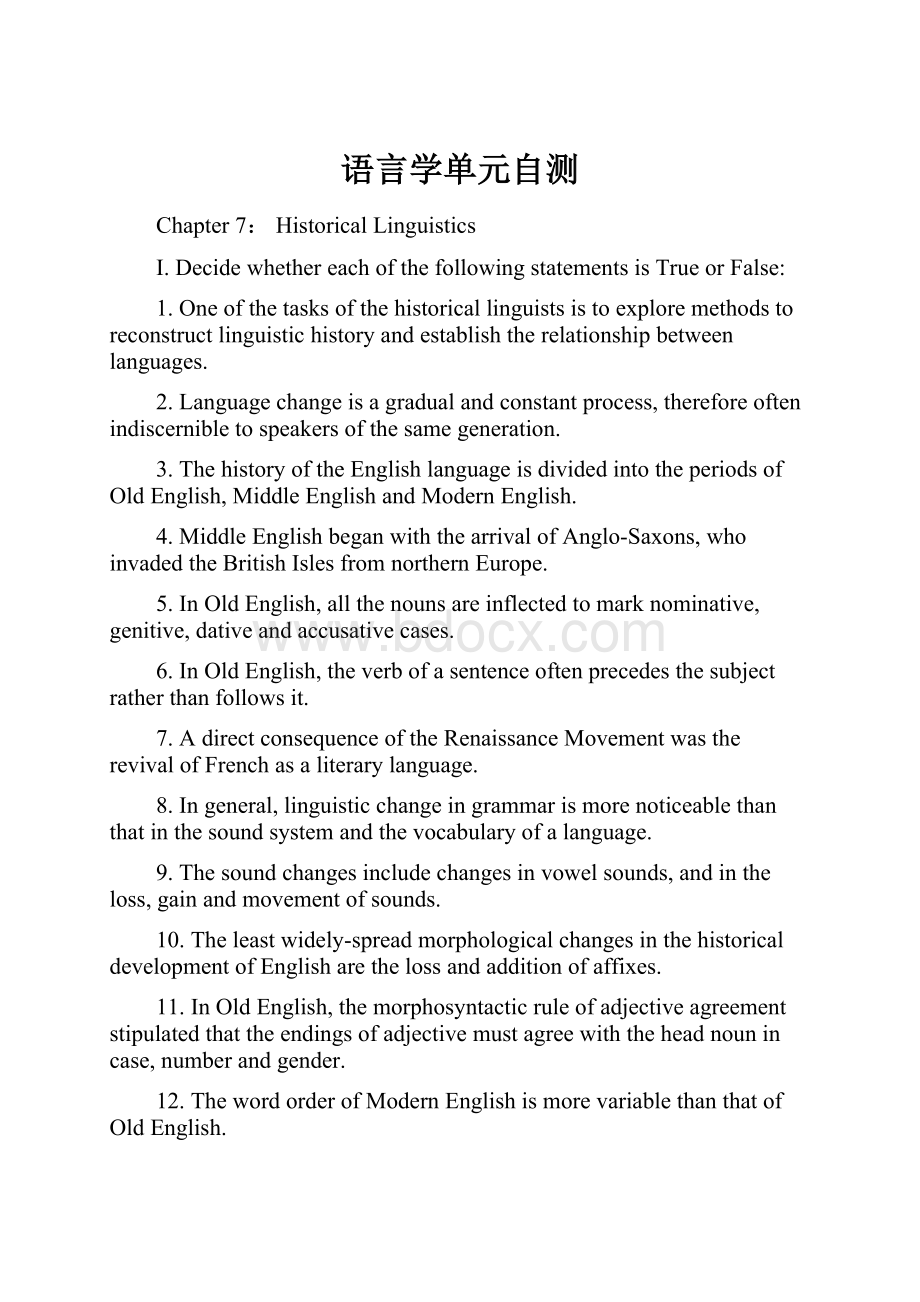语言学单元自测.docx
《语言学单元自测.docx》由会员分享,可在线阅读,更多相关《语言学单元自测.docx(13页珍藏版)》请在冰豆网上搜索。

语言学单元自测
Chapter7:
HistoricalLinguistics
I.DecidewhethereachofthefollowingstatementsisTrueorFalse:
1.Oneofthetasksofthehistoricallinguistsistoexploremethodstoreconstructlinguistichistoryandestablishtherelationshipbetweenlanguages.
2.Languagechangeisagradualandconstantprocess,thereforeoftenindiscernibletospeakersofthesamegeneration.
3.ThehistoryoftheEnglishlanguageisdividedintotheperiodsofOldEnglish,MiddleEnglishandModernEnglish.
4.MiddleEnglishbeganwiththearrivalofAnglo-Saxons,whoinvadedtheBritishIslesfromnorthernEurope.
5.InOldEnglish,allthenounsareinflectedtomarknominative,genitive,dativeandaccusativecases.
6.InOldEnglish,theverbofasentenceoftenprecedesthesubjectratherthanfollowsit.
7.AdirectconsequenceoftheRenaissanceMovementwastherevivalofFrenchasaliterarylanguage.
8.Ingeneral,linguisticchangeingrammarismorenoticeablethanthatinthesoundsystemandthevocabularyofalanguage.
9.Thesoundchangesincludechangesinvowelsounds,andintheloss,gainandmovementofsounds.
10.Theleastwidely-spreadmorphologicalchangesinthehistoricaldevelopmentofEnglisharethelossandadditionofaffixes.
11.InOldEnglish,themorphosyntacticruleofadjectiveagreementstipulatedthattheendingsofadjectivemustagreewiththeheadnounincase,numberandgender.
12.ThewordorderofModernEnglishismorevariablethanthatofOldEnglish.
13.Derivationreferstotheprocessbywhichnewwordsareformedbytheadditionofaffixestotheroots,stems,orwords.
14.“Smog”isawordformedbytheword-formingprocesscalledacronymy.
15.“fridge”isawordformedbyabbreviation.
16.Modernlinguistsareabletoprovideaconsistentaccountfortheexactcausesofalltypesoflanguagechange.
17.Soundassimilationmaybringaboutthelossofoneoftwophoneticallysimilarsyllablesinsequence,asinthecaseofchangeof“Engla-land”to“England”.
18.Ruleelaborationoccurswhenthereisaneedtoreduceambiguityandincreasecommunicativeclarityorexpressiveness.
19.Languagechangeisalwaysachangetowardsthesimplificationoflanguagerules
20.Thewaychildrenacquirethelanguageisoneofthecausesforlanguagechange.
II.Fillineachofthefollowingblankswithonewordwhichbeginswiththelettergiven:
21.H________linguisticsisthesubfieldoflinguisticsthatstudieslanguagechange.
22.Thehistoricalstudyoflanguageisad________studyoflanguageratherthanasynchronicstudy.
23.EuropeanR________MovementseparatestheperiodofMiddleEnglishfromthatofmodernEnglish.
24.Animportantsetofextensivesoundchanges,whichaffected7longortensevowelsandwhichledtooneofthemajordiscrepanciesbetweenphonemicrepresentationsofwordsandmorphemesattheendoftheMiddleEnglishPeriod,isknownastheGreatV_______Shift.
25.A_______involvesthedeletionofaword-finalvowelsegment.
26.Achangethatinvolvestheinsertionofaconsonantorvowelsoundtothemiddleofawordisknownase__________.
27.ThethreesetsofconsonantshiftsthatGrimmdiscoveredbecameknowncollectivelyasGrimmsL____.
28.Soundchangeasaresultofsoundmovement,knownasm_______,involvesareversalinpositionoftwoadjoiningsoundsegments.
29.B________isaprocessbywhichnewwordsareformedbytakingawaythesupposedsuffixesofexitingwords.
30.Semanticb________referstotheprocessinwhichthemeaningofawordbecomesmoregeneralorinclusivethanitshistoricallyearlierdenotation.
31.Theoriginalformofalanguagefamilythathasceasedtoexistiscalledthep_________.
32.Sounda________referstothephysiologicaleffectofonesoundonanother.Inthisprocess,successivesoundsaremadeidenticalorsimilartooneanotherintermsofplaceormannerofarticulation.
33.Inordertoreducetheexceptionalorirregularmorphemes,speakersofaparticularlanguagemayborrowarulefromonepartofthegrammarandapplyitgenerally.Thisphenomenoniscalledi_________borrowing.
34.Byidentifyingandcomparingsimilarlinguisticformswithsimilarmeaningsacrossrelatedlanguages,historicallinguistsreconstructtheprotoforminthecommonancestrallanguage.Thisprocessiscalledc________reconstruction.
35.Them____ruleofadjectiveagreementhasbeenlostfromEnglish.
III.Therearefourchoicesfollowingeachstatement.Markthechoicethatcanbestcompletethestatement:
36.Historicallinguisticsexplores________________.
A.thenatureoflanguagechangeB.thecausesthatleadtolanguagechange
C.therelationshipbetweenlanguagesD.alloftheabove
37.Languagechangeis______________.
A.universal,continuousand,toalargeextent,regularandsystematic
B.continuous,regular,systematic,butnotuniversal
C.universal,continuous,butnotregularandsystematic
D.alwaysregularandsystematic,butnotuniversalandcontinuous
38.ModernEnglishperiodstartsroughly_____________.
A.from449to1100B.from1500tothepresent
C.from1100tothepresentD.from1700tothepresent
39.OldEnglishdatesbacktothemid-fifthcenturywhen_________.
A.theNormanFrenchinvadersunderWilliamtheConquerorarrivedinEngland
B.theprintingtechnologywasinvented
C.Anglo-SaxonsinvadedtheBritishIslesfromnorthernEurope
D.theCelticpeoplebegantoinhabitEngland
40.MiddleEnglishwasdeeplyinfluencedby___________.
A.NormanFrenchinvocabularyandgrammar
B.GreekandLatinbecauseoftheEuropeanrenaissancemovement
C.DanishlanguagesbecauseDenmarkplacedakingonthethroneofEngland
D.theCelticpeoplewhowerethefirstinhabitantsofEngland
41.Languagechangeisessentiallyamatterofchange________.
A.incollocationsB.inmeaning
C.ingrammarD.inusages
42.InOldandMiddleEnglish,both/k/and/n/intheword“knight”werepronounced,butinmodernEnglish,/k/inthesound/kn-/clusterswasnotpronounced.Thisphenomenonisknownas________.
A.soundadditionB.soundloss
C.soundshiftD.soundmovement
43.Achangethatinvolvestheinsertionofaconsonantorvowelsoundtothemiddleofawordisknownas_____.
A.apocopeB.epenthesis
C.parenthesisD.antithesis
44.Segmentswitchofsoundpositionscanbeseenintheexampleofthemodernword“bird”whichcomesfromtheoldEnglishword“bridd”.Thechangeofthewordfrom“bridd”to“bird”isacaseof_________.
A.metathesisB.soundloss
C.soundadditionD.apocope
45._________isaprocessofcombiningtwoormorewordsintoonelexicalunit.
A.DerivationB.Blending
C.CompoundingD.Abbreviation
46.“Wife”,whichusedtorefertoanywoman,standsfor“amarriedwoman”inmodernEnglish.Thisphenomenonisknownas________.
A.semanticshiftB.semanticbroadening
C.semanticelevationD.semanticnarrowing
47.Englishlanguagebelongsto_________.
A.Indo-EuropeanFamilyB.Sino-TibetanFamily
C.AustronesianFamilyD.AfroasiaticFamily
48.Byanalogytothepluralformationoftheword“dog-s”,speakersstartedsaying“cows”asthepluralof“cow”insteadoftheearlierplural“kine”.Thisisthecaseof_________.
A.elaborationB.externalborrowing
C.soundassimilationD.internalborrowing
49.Morphologcialchangescaninvolve__________.
A.thelossofmorphologicalrules
B.theadditionofmorphologicalrules
C.thealterationofmorphologicalrules
D.alloftheabove
50.Themostdramaticmorphologicallossconcernsthelossof________.
A.comparativemarkersB.tensemarkers
C.genderandcasemarkersD.noneoftheabove
IV.Definethefollowingterms:
51.Apocope52.Metathesis53.Derivation
54.back-formation55.semanticnarrowing
57.haplology58.epenthesis59.Compounding
60.Blending61.semanticbroadening62.semanticshift
63.GreatVowelShift64.acronym65.soundassimilation
V.Answerthefollowingquestions:
66.Whatisthepurposeorsignificanceofthehistoricalstudyoflanguage?
67.Whatarethecharacteristicsofthenatureoflanguagechange?
68.WhatarethemajorperiodsinthehistoryofEnglish?
69.Aslanguagechangesovertime,themeaningofawordmaydeviatefromitsoriginaldenotation.Discussthemajortypesofsemanticchanges.
70.OvertheyearsfromOldEnglishperiodtotheModernEnglishperiod,Englishhasundergonesomemajorsoundchanges.Illustratethesechangeswithsomeexamples.
71.Whatarethemostwidely-spreadmorphologicalchangesinthehistoricaldevelopmentofEnglish?
72.WhatarethecausesoflanguagechangeDiscussthemindetail.
Chapter7HistoricalLinguistics
I.DecidewhethereachofthefollowingstatementsisTrueorFalse:
16.F17.T18.T19.F
II.Fillineachofthefollowingblankswithonewordwhichbeginswiththelettergiven:
28.Metathesis35.morphosyntactic
III.Therearefourchoicesfollowingeachstatement.Markthechoicethatcanbestcompletethestatement:
46.D48.D49.D50.C
IV.Definethefollowingterms:
1.Apocope:
Apocopeisthedeletionofaword-finalvowelsegment.
2.Metathesis:
Soundchangeasaresultofsoundmovementisknownasmetathesis.Itinvolvesareversalinpositionoftwoneighbouringsoundseg-ments.
3.Derivation:
Itisaprocessbywhichnewwordsareformedbytheadditionofaffixestotheroots,stemsorwords.
4.back-formation:
Itisaprocessbywhichnewwordsareformedbytakingawaythesupposedsuffixofanexistingword.
5.semanticnarrowing:
Semanticnarrowingisaprocessinwhichthemeaningofawordbe-comeslessgeneralorinclusivethanitshist